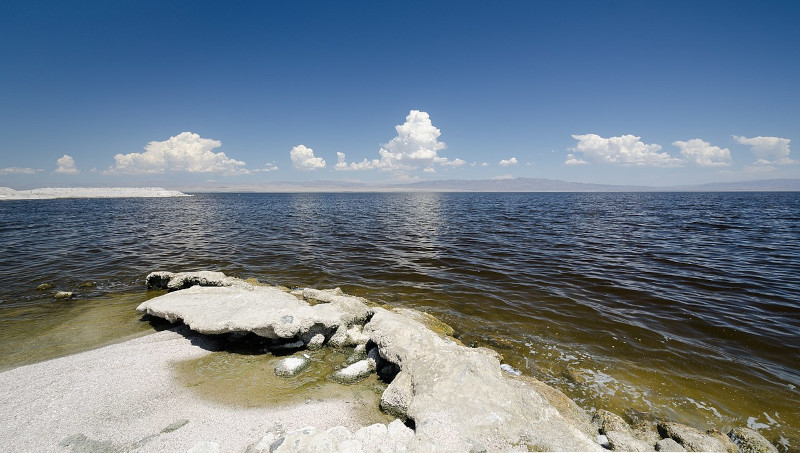Salton Sea Facts
- The deceptive simple term of Salton Sea represents the most frequently employed name for this remarkable creation of Nature. Yet, the marvel does have several other general titles by which it’s known. These include Lake Cahuilla, Salt Creek Sea, and The Accidental Sea.
- The epither by which it’s best known remains deceptive due to the nature of the site itself. That’s true since it’s not actually a sea at all. Instead, the amazing feature constitutes a lake, though admittedly of respectable dimensions and highly unusual nature and history.
- This region undergoes periodic cycles of flooding and drying across many thousands of years. Archaeological evidence indicates that Indigenous Peoples long knew of its existence. Those clear indications include the discoveries of ancient fishing traps and petroglyphs.
- Historical evidence also indicates, though, that European explorers did not enter the region until sometime between 1774-1776. At that time, the Spanish explorer, Juan Bautista de Anza led several expeditions into the area. At that time, however, he found only vast dry lake beds.
- Fortunately, the fascinating Salton Sea does now enjoy a certain degree of protection from the depredations of man due to the presence of several actions. These include the establishment of a National Wildlife Refuge and the Salton Sea Management Program in the region.
- Sadly, though, this marvelous and highly unusual feature nevertheless still faces numerous challenges. Decreasing water inflows continue to cause the body of water to shrink, increasing its salinity. Fish die-offs and habitat loss threaten migratory birds that depend on the sea.
Related Articles
Salton Sea Physical Description
The mesmerizing Salton Sea generally creates precisely that reaction among those individuals viewing it for the first time, it leaves them entranced. Yet, the body of water doesn’t have this effect for a single reason alone. Instead, it’s more an accumulation of intrigue due to multiple factors.
In its currrent incarnation, this marvel of Nature displays some reasonably impressive dimensions. Though understandably irregular in outline, it possesses a roughly elongated, rectangular shape. Its exact shape changes, however, due to variations in such things as inflow and rates of evaporation.
Overall, though, at present this intriguing lake measures approximately 35 mi (56 km) at its longest point. It also currently boasts a width at its greatest span equaling roughly 15 mi (24 km). The most recent survey of the feature placed its total surface area at about 343 sq mi (889 sq km).
Despite these moderately impressive physical dimensions, the distinctive lake nevertheless remains relatively shallow in nature. Astonishingly, its average depth only equals about 29.9 ft (9.1 m). Even at its greatest depth at present, its unusual waters only reach a maximum depth of 51 ft (16 m).
Yet, the Salton Sea merits attention for still other attributes. Its salinity level stands at roughly 4.4%. By comparison, the average salinity level of the earth’s oceans measures 3.5%. Adding to the body’s uniqueness is the presence of mudflats and areas of salt encrustacean along the shore.
Salton Sea Location, Formation, and Ecology
The attention-grabbing Salton Sea formed in a region of the globe already well known for its abundance of natural marvels, both biological and geological. That location therefore likely won’t surprise many individuals. The atypical lake formed in a portion of the continent of North America.
There, the wonder lies within the western confines of the United States. It’s further situated in the southern section of the state of California. That placement puts it well inside the borders of the starkly beautiful Sonoran Desert. Amazingly, it also lies approximately 236 ft (72 m) below sea level.
Uniquely, the present iteration of this wonder formed due to a man-made accident. That took place in 1905 when the Colorado River accidentally breached an irrigation canal, causing massive flooding into the Salton Basin. This continued unchecked for 2 years before repairs stopped the inflow.
Historically, however, the lake forms on a periodic basis naturally, anyway. That occurs due to shifting in the course of the above-mentioned river, due to various factors. When the river later alters is course once again, these bodies slowly dry up, leaving substantial deposits of salt behind.
In its present accidentally and artificially created form, this wonder of geology shelters a rapidly changing ecosystem with unique characteristics and challenges. Initially, it supported a diverse aquatic and bird population, but rising salinity, pollution, and water loss have led to severe decline.
The Salton Sea forms a crucial stopover on the Pacific Flyway, making it one of North America’s most important bird habitats. To date, researchers know of more than 400 avian species making use of it for that purpose. Among others, these include the Great Blue Heron, egrets, gulls, and terns.
Historically, the lake also supported reasonably significant populations of several introduced fish species. Those included tilapia, corvina, croaker, and sargo. Due to multiple ongoing environmental changes, though, only the tilapia continue to be present in anything approaching large numbers.
Interestingly enough, however, Nature’s proving her adaptability in this remarkable setting. The various varieties of fish continue to decline in number due to increasing salinity levels. Yet, the same rise in that aspect of the water is creating a rise in the population of brine flies and brine shrimp.
Features Sharing Its Region
Check out our other articles on 6 Stunning North American Bees, Red-legged Pademelon, McMurdo Dry Valleys, Fall Phlox, Black and scarlet Cicada, Rose’s Ghost Frog, Tiger Shark, Orinoco Crocodile

